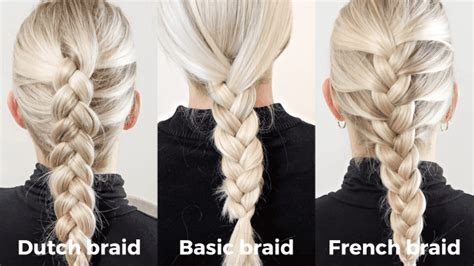Dutch vs. French: An Overview
When it comes to creating intricate and stylish hairstyles, Dutch and French braids stand out as two of the most popular options. While both techniques involve weaving three strands of hair together, they differ in their execution and overall appearance.

- Dutch Braid: Also known as an “inside-out” braid, the Dutch braid is characterized by its raised, textured appearance. The strands are crossed underneath one another, creating a braid that sits prominently on top of the head.
- French Braid: In contrast, the French braid is an “outside-in” braid that lies flatter against the scalp. The strands are crossed over one another, resulting in a more subtle and elegant look.
Pros and Cons of Dutch Braids
Pros:
- Volume and lift: Dutch braids create a voluminous and lifted effect, making them ideal for adding height and body to hair.
- Secure hold: The raised pattern of a Dutch braid helps distribute weight evenly, providing a secure hold that can last for hours.
- Versatility: Dutch braids can be styled in various ways, from classic three-strand braids to intricate crowns and updos.
Cons:
- Pain during braiding: The inside-out crossing technique can put tension on the scalp, potentially causing discomfort during braiding.
- Less formal appearance: Due to their raised texture, Dutch braids may not be suitable for formal occasions that call for a more polished look.
Pros and Cons of French Braids
Pros:
- Flattering appearance: French braids create a smooth and sophisticated look that complements most face shapes.
- Versatile: Similar to Dutch braids, French braids can be styled in numerous ways, including classic braids, side braids, and fishtails.
- Pain-free braiding: The outside-in crossing technique eliminates scalp tension, making French braids less painful to create.
Cons:
- Less volume: Compared to Dutch braids, French braids lie closer to the scalp, resulting in less height and volume.
- Can loosen easily: If not braided tightly enough, French braids may come undone or loosen over time.
Comparison of Key Features
To provide a more comprehensive comparison, consider the following key features:
| Feature | Dutch Braid | French Braid |
|---|---|---|
| Texture | Raised, textured | Smooth, flat |
| Appearance | Bulky, bold | Delicate, elegant |
| Braiding technique | Inside-out crossing | Outside-in crossing |
| Pain during braiding | Yes | No |
| Versatility | High | High |
| Volume | Yes | No |
| Security | Yes | Yes (if braided tightly) |
Applications of Dutch and French Braids
Both Dutch and French braids have a wide range of applications, depending on the desired style and occasion.
Dutch Braids:
- Everyday wear: Dutch braids are perfect for creating a whimsical and unique look for everyday activities.
- Sports: Dutch braids can help keep hair out of the face during workouts and competitions.
- Special occasions: Intricate Dutch braids can elevate any formal or special event hairstyle.
French Braids:
- Everyday wear: French braids are a versatile choice for both casual and formal settings.
- Weddings and special events: French braids are often used to create elegant hairstyles for brides and bridesmaids.
- For sleeping: French braids can help prevent tangles and keep hair smooth while sleeping.
Common Mistakes to Avoid
To ensure successful braiding, avoid these common mistakes:
- Braiding too tightly: Over-tightening can cause scalp pain and hair breakage.
- Using too much hairspray: Excessive hairspray can make braids stiff and unnatural.
- Not braiding from the crown: Starting braids too low can result in a loose and untidy look.
- Not crossing the strands consistently: Inconsistent crossing can create an uneven and messy braid.
- Not securing braids properly: Unsecured braids may come undone easily.
FAQs
1. Which braid is easier to create, Dutch or French?
French braids are generally considered easier to create due to the less painful outside-in crossing technique.
2. Which braid lasts longer, Dutch or French?
Both braids can last for several hours, but Dutch braids may hold better due to their raised texture and secure hold.
3. Can Dutch braids be worn for a formal event?
Intricately styled Dutch braids can be appropriate for formal events, but French braids may be a better choice for a more polished look.
4. Can French braids be worn while sleeping?
Yes, French braids can help prevent tangles and protect hair from damage while sleeping.
5. Can Dutch braids be pulled into a ponytail?
Yes, Dutch braids can be pulled into a ponytail for a sporty or casual look.
6. Can French braids be combined with other braiding techniques?
Yes, French braids can be combined with Dutch braids, fishtails, and other braiding techniques to create unique and visually stunning hairstyles.
